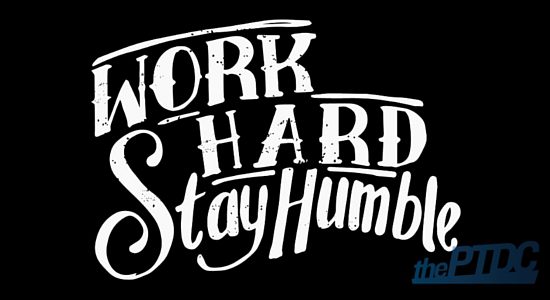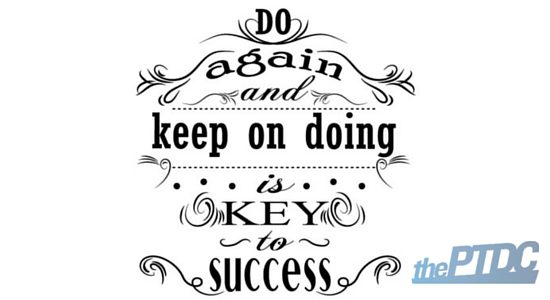Once in a while, I'd get a message from a younger coach, asking me how to become successful, and then I'd start grinning like a little kid on his birthday.
It's humbling as heck to be perceived as "successful" by your peers. The first time I got that question I asked myself, "Hold on, when did I become successful?" Truly puzzled, I went back through my diary, but didn't see a day or a time when I had noted my arrival at "success."
In reality, I don't think there is just one indicator.
I wish it were just one thing that could make me successful. Likewise, I wish I could get just one certification to make me successful. But it's actually been a culmination of putting in the hours for days, months, and years; believing that my hard work will eventually pay off because others aren't willing to do the same; and being honest and real with people.
Whatever the case, I suppose I'm some place where others want to be, but I walked a long, meandering, and oftentimes, unsexy road to get here. At the risk of sounding like the rapper Drake, I started from the bottom...
The start of my training career was really nothing special.
My life as a trainer started in 2009, when I was a 12th grader and started working for a big gym as a "member ambassador." That was just a fancy title whose actual job description was simply show new members where the machines were and make sure all the weights were in the right place, which paid $8.50 an hour.
That's what I did every day after school for six months.
Toward the end of that six-month period, I realized I could be a good personal trainer. (I mean, I was training myself at the time, and it seemed to be working!) I studied for one weekend and got my personal training certification. I applied for a job and got in as a trainer at another big box gym. It paid $16 per hour, but that was only when I was training someone. For months, I would spend my time between 4 p.m. to 10 p.m. after school at the gym, scouting for new clients. I made about $300 during the three months that I'd stayed with that gym.

ALSO READ --> How to Raise Your Personal Trainer Rates
I quit that job and got a job at the local YMCA for $20 an hour--a decent pay raise. At the same time, I started to do in-home training most mornings before my 8 a.m. university classes for $30 an hour. My earnings gradually went up, but as you can see, I was spending a lot of time working alongside balancing school.
Once I graduated with my kinesiology degree, I quit the YMCA and spent the next two years working at two high-end gyms, getting paid $25 per hour in the first year and then $30 per hour in the second. I gained a lot of experience, learning about coaching, business, and more importantly, my worth.
By the start of 2015, I had enough private clients to justify quitting to start my own gig. I could charge $90+ per hour and keep all of it. Of course, my clients didn't just show up at my door. I had spent evenings in the past year literally knocking on doors, dropping off flyers, asking for referrals, and emailing any person I could.
My efforts paid off. Toward the end of 2015, I used the money I had earned and invested it toward my professional growth as a coach to intern at two world-class facilities: ALTIS and Cressey Sports Performance. I'd learned more about coaching, programming, and communication in the six months I interned with them than I would have from just sticking to seminars, DVDs, and books for two or three years.
I changed the way I thought about "success."
I will admit that I wasn't always patient. Prior to going to the U.S. to intern, I'd frequently gotten disheartened about the lack of "success" with my work.
I felt that I'd been working my ass off, but was not getting enough in return.
This type of thinking is common, but one book in particular completely changed my mindset.
It's called The Slight Edge: Turning Simple Disciplines into Massive Success and Happiness by Jeff Olson. In that book, Olson lays out what successful people do. Reading it really shifted the way I think about success. He wrote a particularly memorable quote:
"Successful people just do the things that seem to make no difference in the act of doing them and they do them over and over and over until the compound effect kicks in."
And that's what I've been doing for the last three years.
 To name a few things, I always asked for referrals once a week, continued to build relationships and alliances within the neighborhood, woke up early to send a message to an existing client to let them know I'm thinking of them, and contributed to conversations and stayed active on social media. These are things that you might already be doing, but you might only do them in spurts every few months, rather than daily.
To name a few things, I always asked for referrals once a week, continued to build relationships and alliances within the neighborhood, woke up early to send a message to an existing client to let them know I'm thinking of them, and contributed to conversations and stayed active on social media. These are things that you might already be doing, but you might only do them in spurts every few months, rather than daily.
Most of my existing online clients are people who have been been on my email list or following me on social media for at least six months. And the first email usually goes something like this, "Hey I've been seeing the things you post for a while and I think you can help me X."
It pays to be consistent and doing things over and over again, even if they don't feel huge or that important.
The most important things you should be doing (but probably aren't).
I shared my story because I wanted to demonstrate that I put in the work and sweat for many years to make my path. This is in contrast to the idea of getting things immediately. We live in a world of instant gratification, in which a weekend course and an investment of a couple thousand dollars give you letters beside your name--letters that clients don't know the meaning of--and suddenly, you're a personal training specialist!
The truth is, a degree in kinesiology and a weekend personal training certification aren't enough to make you successful. Those things are just the icing on the cake. Everyone is doing those things. However, these are what most people aren't doing (with inspiration from Olson's book):
- Accept a lower starting pay to build up your experience: Too often I hear young coaches not accepting an entry level training job because it doesn't pay enough. Just as a swimmer becomes a better swimmer by swimming more, you can become a better coach by coaching more. Big box gyms are the fastest way to learn what works and what doesn't, as well as highlight areas you need to focus more on.
- Spend more time making note of clients' birthdays and anniversaries: The surest way to maintain relationships and make them stronger is to remember important days and small details. This applies to any type of relationship, not just work. And it only takes a minute to set a new alarm for a client's birthday, anniversary, or special day on your phone's calendar.
- Spend more time coaching, in the gym and after the session. You're still a coach after the session. That includes text messaging, Skype, emails, and "office visits." If you think your pay should reflect the number of hours you work, you might as well find another field to work in. We're selling personal training here. Get more involved with your clients during the 23 hours outside of your sessions. Learn more about them and see what issues might impact their performance in the gym, and their results. If you one of your clients works in the neighborhood, grab a lunch and take it to his or her office. That's going the extra mile.
- Check in and let your clients know you're their coach 24/7. I like to check in regularly with clients and ask how they feel after their workout from the day before, how they slept, and what they want more of in their next session. This shows you them that you care, and it also allows you to plan your sessions better around their rest and feedback.
- Learn how other coaches interact with their clients. I've been lucky enough to intern at a couple of world-class facilities. The common trait I found among the coaches I was shadowing wasn't their use of fancy exercises, but rather the way they talked to clients and athletes. It wasn't their overwhelming knowledge of exercise science, but their use of open-ended questions and their ability to break down complex information into simple terms. As we often say in the industry, speak in your client's language.
- Wake up a little earlier every day and see how you can serve your clients better. One of my favorite quotes is from Brett Bartholomew: "As coaches, we not only strengthen physically, but mentally and spiritually." When a client asks me about an issue that I don't have the answer to, I do one of two things: Read up about it, or get in touch with someone in my network immediately. For me, the hours of 3 a.m. to 6 a.m. are prime time for uninterrupted work. You don't have to wake up at these times, but be sure to allocate an hour a day during your uninterrupted hours to solve problems, or learn more about topics that are important to your clients' goals.
 These things are crucial because "making it" and setting yourself apart in an industry with absolutely no barrier to entry--where my 83-year-old grandma can become a personal trainer--is a challenge.
These things are crucial because "making it" and setting yourself apart in an industry with absolutely no barrier to entry--where my 83-year-old grandma can become a personal trainer--is a challenge.
It's easy to become discouraged and think you're falling behind when there are a handful of YouTube fitness sensations, but most "successful" coaches are actually well in their 30s and 40s (and less "out there"). They've put in the time to master their craft, gain experience, and build relationships. These are the coaches you and I should look up to as mentors.
So now whenever someone asks me for tips on what made me successful, I just say: be patient, be persistent, and do the little things every day. Because others won't.
Other trainers found these articles helpful:
- 3 Tips For a Successful Career in Fitness By Tammy Lee Bower
- The Key to Fitness Business Success: Follow Your Own Advice By Jennette Holzworth
- The Secret to Developing Trust and Increasing Client Retention By Dick Talens










